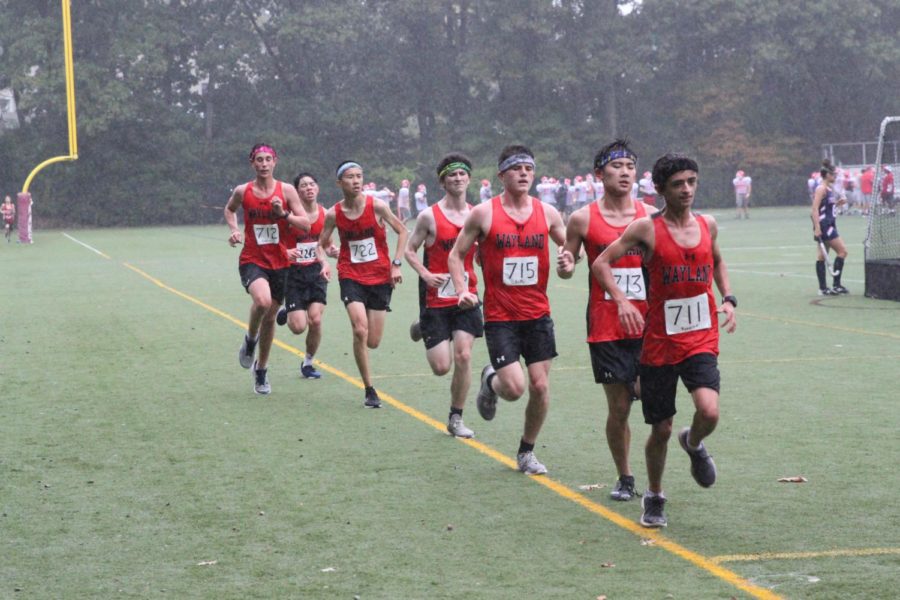Tracking the Team: Cross Country
Examining the emotional, physical strengths required for cross country runners
Credit: Courtesy of the WHS Reflector
As the season is coming to a close, the WHS cross country athletes are excited to see the progress they have made throughout the season. “I’m looking forward to meets at the end of the season where I can just improve my times just as much as I can and go all out,” junior cross country runner Dylan Bonanno said.
October 29, 2019
During the winter and spring, the track and field team prepares itself for a season full of leaping over hurdles, throwing weights or hurdling over the vault with a tall pole. But while track consists of many different events, runners in the fall compete in cross country, which offers a different twist on the sport.
One of the main differences between track and cross country is the distance athletes run. Track largely covers the shorter distance events, whereas cross country involves longer courses.
“The biggest difference is that cross country is literally not on a track, and it’s a longer distance,” junior cross country runner Dylan Bonanno said. “In track, the longest distance is the two-mile, but in cross country, we run 5k’s mostly, which [are] 3.1 miles and not on a track. It’s usually in the woods or sometimes on pavement, so it’s a different style.”
Along with the different surfaces in cross country, the longer distance presents new challenges for athletes. Unlike track, in which race events range from 15 minutes all the way down to ten seconds, cross country can be much more time-consuming.
“Of all the sports offered at the high school, cross country is among the top two in terms of taking the longest amount of time to complete the event without any breaks, timeouts or substitutions,” cross country coach Mark Mayall said. “Nordic skiing is the only other sport that has longer events without a break. To say it’s exhausting is a massive understatement.”
With the majority of the season having passed, both the coaches and track runners have adapted to the transition from track to the lengthy hills and dirt paths. Although the runners are already aware of the difficulty in cross country, Mayall ensured that the change of surfaces wouldn’t be too drastic by having them run over the summer.
“I challenged the returning athletes to be more focused and disciplined in their preparations for the season over the summer months, and by and large they rose to the challenge,” Mayall said. “Both teams are very intrinsically motivated to train and improve their fitness by consistently putting in the time. There are no passengers on either team.”
For cross country runners like senior Owen Jay, the preparation for each cross country season never really stops. The challenge of improving in-season and out-of-season becomes a year-round goal for the cross country team.
“I’d say the most challenging part is the offseason,” Jay said. “After [the track] season, you kind of want to take a break, but you have to stay motivated and train for the upcoming cross-country season. My coaches like to tell me that the next cross-country season begins in track season, so you’ve got to keep training through the offseason and stay dedicated.”
Team members have a series of workouts and exercises they use in order to stay competitive and in shape during the cross country season. In order to maintain the necessary fitness to run the long distances, athletes must complete a variety of training exercises.
“We have long runs which develop endurance, and then we have speed workouts, [which are] two of our hard workouts. When we’re not doing that, we’ll do a recovery run so our muscles can recover,” Jay said. “Outside of running, we try to work core and legs just so [we] can have a stronger body [in] the long run.”
Along with continuous structured runs, the team also focuses on another key part of cross country in practice, which is pacing. According to Bonanno, pacing yourself throughout your runs is one of the most challenging obstacles that a runner faces.
“You don’t want to go out too fast or too slow, [so] you have to find a good balance,” Bonanno said. “In our workouts, we do a lot of pace training – we stay good, hard and intense, and we do certain distances on the aqueduct. You should know your 400 split for race pace so that you can get a feel for what that is and get comfortable with it.”
Cross country is incredibly demanding, both physically and mentally. Keeping these factors in mind, Mayall hopes that his athletes will grow by responding to these demands throughout the season.
“My hope is that everyone who’s participated on the team this season will have discovered previously unexplored depths of physical and emotional strength,” Mayall said. “This type of hard-won self knowledge is priceless in my opinion.”
Although Jay is a new student at WHS from St. Louis, Missouri, he has found strength in his new cross country team in Wayland and is hopeful for the rest of the season.
“Although I don’t have the same teammates as I did [in St. Louis], these guys have all really taken me in, and we’ve all worked together to get better,” Jay said.
Despite the chills and frosts just around the corner, the season is still far from over, as the team is now preparing for the upcoming state playoffs.
“I’m looking forward to states,” Jay said. “We’ve been working hard all season, and we really want to qualify for all states, so that would definitely be a highlight if we could do that. We’re all pretty motivated to do that.”





![Last Wednesday, the Wayland School Committee gathered to discuss a number of topics regarding the health curriculum and Innovation Career Pathway course. Another large topic of conversation was the ways to potentially mitigate distracting cell phone usage. "These [phones] are going to distract your learning and social relationships," Superintendent David Fleishman said. "That's concrete right there."](https://waylandstudentpress.com/wp-content/uploads/2025/06/Screenshot-2025-06-04-at-9.49.31 PM-1200x886.png)



























![Troy Hoyt finishes the Boston Marathon, running for the Hoyt Foundation. T. Hoyt is the son of Hoyt Foundation CEO Russ Hoyt.
“[Running a marathon] might seem like a big thing, when it’s presented to you at first, but if you break it up and just keep telling yourself, “Yes, you can,” you can start chipping away at it. And before you know it, you’ll be running the whole 26 miles, and you won’t even think twice about it.” T. Hoyt said.](https://waylandstudentpress.com/wp-content/uploads/2025/04/C36E8761-1CBB-452E-9DF2-543EF7B1095E_1_105_c.jpeg)














































